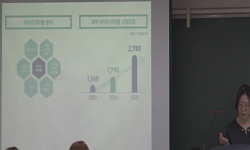This study aimed to investigate the convergence relationship between kinesiophobia and fear of falling in patients with stroke. A total of 113 patients with stroke participated in this study. Participants underwent inpatient rehabilitation and complet...
http://chineseinput.net/에서 pinyin(병음)방식으로 중국어를 변환할 수 있습니다.
변환된 중국어를 복사하여 사용하시면 됩니다.
- 中文 을 입력하시려면 zhongwen을 입력하시고 space를누르시면됩니다.
- 北京 을 입력하시려면 beijing을 입력하시고 space를 누르시면 됩니다.

Convergence Study on the Relationship between Kinesiophobia and Fear of Falling in Patients with Stroke
한글로보기https://www.riss.kr/link?id=A106405444
- 저자
- 발행기관
- 학술지명
- 권호사항
-
발행연도
2019
-
작성언어
English
-
주제어
Convergence ; Kinesiophobia ; Fear of falling ; Stroke ; 융합 ; 운동공포증 ; 낙상공포 ; 뇌졸중
-
등재정보
KCI등재
-
자료형태
학술저널
-
수록면
33-41(9쪽)
-
KCI 피인용횟수
0
- DOI식별코드
- 제공처
-
0
상세조회 -
0
다운로드
부가정보
다국어 초록 (Multilingual Abstract)
This study aimed to investigate the convergence relationship between kinesiophobia and fear of falling in patients with stroke. A total of 113 patients with stroke participated in this study. Participants underwent inpatient rehabilitation and completed surveys with three different questionnaires including the fall efficacy scale (FES), translated Tampa Scale for Kinesiophobia 13 (TSK-13), and activity-specific balance confidence scale (ABC). TSK-13 and FES showed weak negative correlation (r=-0.226), and TSK-13 and ABC showed moderate negative correlation (r=-0.300). FES had a very strong positive relationship compared with ABC (r=0.838). Faller showed significantly low FES and ABC scores compared with non-faller (p<0.05). These results present that patients with stroke had mild kinesiophobia, and kinesiophobia is related to fear of falling. It is necessary to evaluate kinesiophobia in stroke rehabilitation.
참고문헌 (Reference)
1 E. N. Thomas, "The importance of fear, beliefs, catastrophizing and kinesiophobia in chronic low back pain rehabilitation" 53 (53): 3-14, 2010
2 H. Naess, "The effects of fatigue, pain, and depression on quality of life in ischemic stroke patients: the Bergen Stroke Study" 8 : 407-413, 2012
3 J. Pigman, "The development and feasibility of treadmill-induced fall recovery training applied to individuals with chronic stroke" 19 (19): 102-, 2019
4 S. N. Jang, "The Validity and Reliability of Korean Fall Efficacy Scale(FES) and Activities-specific Balance Confidence Scale(ABC)" 7 (7): 255-268, 2003
5 P. D. Slade, "The Fear-Avoidance Model of exaggerated pain perception--II" 21 (21): 409-416, 1983
6 L. E. Powell, "The Activities-specific Balance Confidence (ABC) Scale" 50a (50a): 28-34, 1995
7 B. M. Stasny, "The ABC Scale and Fall Risk: A Systematic Review" 29 (29): 233-242, 2011
8 E. Lundstrom, "Risk factors for stroke-related pain 1 year after first-ever stroke" 16 (16): 188-193, 2009
9 A. Czernuszenko, "Risk factors for falls in stroke patients during inpatient rehabilitation" 23 (23): 176-188, 2009
10 A. Schinkel-Ivy, "Relationships between fear of falling, balance confidence, and control of balance, gait, and reactive stepping in individuals with sub-acute stroke" 43 : 154-159, 2016
1 E. N. Thomas, "The importance of fear, beliefs, catastrophizing and kinesiophobia in chronic low back pain rehabilitation" 53 (53): 3-14, 2010
2 H. Naess, "The effects of fatigue, pain, and depression on quality of life in ischemic stroke patients: the Bergen Stroke Study" 8 : 407-413, 2012
3 J. Pigman, "The development and feasibility of treadmill-induced fall recovery training applied to individuals with chronic stroke" 19 (19): 102-, 2019
4 S. N. Jang, "The Validity and Reliability of Korean Fall Efficacy Scale(FES) and Activities-specific Balance Confidence Scale(ABC)" 7 (7): 255-268, 2003
5 P. D. Slade, "The Fear-Avoidance Model of exaggerated pain perception--II" 21 (21): 409-416, 1983
6 L. E. Powell, "The Activities-specific Balance Confidence (ABC) Scale" 50a (50a): 28-34, 1995
7 B. M. Stasny, "The ABC Scale and Fall Risk: A Systematic Review" 29 (29): 233-242, 2011
8 E. Lundstrom, "Risk factors for stroke-related pain 1 year after first-ever stroke" 16 (16): 188-193, 2009
9 A. Czernuszenko, "Risk factors for falls in stroke patients during inpatient rehabilitation" 23 (23): 176-188, 2009
10 A. Schinkel-Ivy, "Relationships between fear of falling, balance confidence, and control of balance, gait, and reactive stepping in individuals with sub-acute stroke" 43 : 154-159, 2016
11 C. B. Terwee, "Quality criteria were proposed for measurement properties of health status questionnaires" 60 (60): 34-42, 2007
12 C. L. Hoang, "Physical factors associated with fatigue after stroke: an exploratory study" 19 (19): 369-376, 2012
13 Z. Trost, "Pain-related fear and avoidance of physical exertion following delayed-onset muscle soreness" 152 (152): 1540-1547, 2011
14 S. Anandkumar, "Multimodal physical therapy management of a 48-year-old female with post-stroke complex regional pain syndrome" 30 (30): 38-48, 2014
15 S. H. Kori, "Kinesiophobia: A new view of chronic pain behavior" 3 (3): 35-43, 1990
16 J. Nijs, "Kinesiophobia, catastrophizing and anticipated symptoms before stair climbing in chronic fatigue syndrome: an experimental study" 34 (34): 1299-1305, 2012
17 F. Doury-Panchout, "Kinesiophobia negatively influences recovery of joint function following total knee arthroplasty" 51 (51): 155-161, 2015
18 M. Back, "Kinesiophobia mediates the influences on attendance at exercise-based cardiac rehabilitation in patients with coronary artery disease" 32 (32): 571-580, 2016
19 D. Sethy, "Kinesiophobia after complex regional pain syndrome type one in a case of stroke hemiplegia and effect of cognitive behavior therapy" 60 (60): 152-154, 2018
20 B. Stubbs, "Is there a relationship between pain and psychological concerns related to falling in community dwelling older adults? A systematic review" 36 (36): 1931-1942, 2014
21 T. Suzuki, "Incidence and consequence of falls in inpatient rehabilitation of stroke patients" 31 (31): 457-469, 2005
22 T. Gorst, "Foot and ankle impairments affect balance and mobility in stroke (FAiMiS): the views and experiences of people with stroke" 38 (38): 589-596, 2016
23 K. Delbaere, "Fear-related avoidance of activities, falls and physical frailty. A prospective community-based cohort study" 33 (33): 368-373, 2004
24 I. E. Swinkels-Meewisse, "Fear of movement/(re)injury predicting chronic disabling low back pain: a prospective inception cohort study" 31 (31): 658-664, 2006
25 D. J. French, "Fear of movement/(re)injury in chronic pain: A psychometric assessment of the original English version of the Tampa scale for kinesiophobia (TSK)" 127 (127): 42-51, 2007
26 J. W. S. Vlaeyen, "Fear of movement/(re)injury in chronic low back pain and its relation to behavioral performance" 62 (62): 363-372, 1995
27 Y. Watanabe, "Fear of falling among stroke survivors after discharge from inpatient rehabilitation" 28 (28): 149-152, 2005
28 T. W. Liu, "Fear Avoidance Behavior, Not Walking Endurance, Predicts the Community Reintegration of Community-Dwelling Stroke Survivors" 96 (96): 1684-1690, 2015
29 M. E. Tinetti, "Falls efficacy as a measure of fear of falling" 45 (45): P239-P243, 1990
30 R. Neblett, "Establishing clinically meaningful severity levels for the Tampa Scale for Kinesiophobia (TSK-13)" 20 (20): 701-710, 2016
31 M. Monticone, "Development of the Tampa Scale of Kinesiophobia for Parkinson's disease:confirmatory factor analysis, reliability, validity and sensitivity to change" 38 (38): 113-120, 2015
32 Sadhana Verma, "Correlation Between Pain, Fear of Falling and Disability in Low Back Pain" 대한재활의학회 39 (39): 816-820, 2015
33 N. Ulug, "Comparison of pain, kinesiophobia and quality of life in patients with low back and neck pain" 28 (28): 665-670, 2016
34 M. J. O'Donnell, "Chronic pain syndromes after ischemic stroke: PRoFESS trial" 44 (44): 1238-1243, 2013
동일학술지(권/호) 다른 논문
-
기업의 리뷰척도 및 포스팅 정보와 구매패턴과의 관계분석-아마존 구글 유저를 중심으로
- 한국융합학회
- 김동일
- 2019
- KCI등재
-
도시재생사업활성화를 위한 주민대학 사례연구: 강점모델을 기반으로 한 융합적 접근
- 한국융합학회
- 김남숙
- 2019
- KCI등재
-
- 한국융합학회
- 김유호
- 2019
- KCI등재
-
금속 내부의 이물질 검출 향상을 위한 X-ray 영상 보정 모델
- 한국융합학회
- 김원
- 2019
- KCI등재
분석정보
인용정보 인용지수 설명보기
학술지 이력
| 연월일 | 이력구분 | 이력상세 | 등재구분 |
|---|---|---|---|
| 2025 | 평가예정 | 신규평가 신청대상 (신규평가) | |
| 2022-06-01 | 평가 | 등재학술지 취소 | |
| 2019-01-01 | 평가 | 등재학술지 유지 (계속평가) |  |
| 2016-01-01 | 평가 | 등재학술지 선정 (계속평가) |  |
| 2014-01-01 | 평가 | 등재후보학술지 선정 (신규평가) |  |
학술지 인용정보
| 기준연도 | WOS-KCI 통합IF(2년) | KCIF(2년) | KCIF(3년) |
|---|---|---|---|
| 2016 | 5.85 | 5.85 | 0 |
| KCIF(4년) | KCIF(5년) | 중심성지수(3년) | 즉시성지수 |
| 0 | 0 | 0 | 0.76 |





 ScienceON
ScienceON eArticle
eArticle






